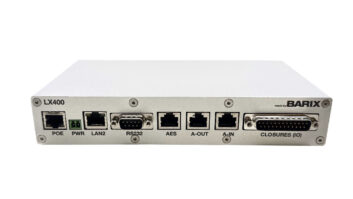
Tom Hartnett, Comrex. Technical Director. ‘I feel strongly that it’s time to leverage the benefits of IP codecs into the station’s on-air phone system.’
Radio World asked several codec suppliers about trends in their area of expertise and we got back some great information. This is one in a series.
How have codecs changed in recent years?
Hartnett: Besides the general movement from ISDN to IP, codecs have certainly made inroads in providing solid performance over “average-quality” wired IP links.
Most good modern codecs have dynamic buffer managers and other tools to compensate for the “raw” nature of the public Internet. We hear of very few operational issues these days, beyond initial setup, from wired IP users.
On the wireless end, seamless integration with things like 4G and Wi-Fi is hot. Also codec manufacturers now deploy compatible modes so they can talk to each other. And finally, several manufacturers have introduced lower-cost, simpler devices that bring the benefits of IP codecs to a larger user base.
In what direction is codec design heading?
Hartnett: The industry hasn’t seen a mass migration to laptop-based codecs, although they exist. We’ve been concentrating on providing easy interface to existing smartphone apps as companions our hardware codecs, as there is a definite segment of user who is excited about that. But there are limits to smartphone codecs — like form factor, wireless-only operation and lack of stereo — and there are many users (e.g., voiceover, sportscasting, studio-studio, backup STL) for which they’ll never make sense.
I feel strongly that it’s time to leverage the benefits of IP codecs into the station’s on-air phone system. We’ve introduced an IP-based multi-line call in system that does all the old-fashioned telephone integration, but can also take calls from codec users (and wideband smartphone apps) and blends them seamlessly into the same conference.
Are engineers leery of relying on the Internet for mission-critical audio transport?
Hartnett: Engineers just need to be smart about where they are applying these tools. Most smart customers know not to show up to a ballgame with 30,000 smartphone users and expect good results on 3G. And not to buy a $35/month consumer-grade DSL as your STL backbone.
Of course there’s a lot of different kinds of users, and sometimes projects are green-lighted only because they can be done cheaply. I find those the most interesting and fun, but in most cases those types of projects can survive some rocky performance.
But as far as real pros with budgets and reliability needs, they can be met with smart design and planning, and installation of wired Internet whenever possible.
This is an important point: Wireless services can be a nice shortcut for quick-shots and reporters, but will never rival the reliability of wired. And mission-critical wired IP requires QoS arrangements and Service Level Agreements. In the early days, it was pretty common for users to try IP coding, have a failure and announce the technology “not ready.” There’s too much cost-savings at stake to ignore IP codecs anymore.
What is the “state of the art” in bitrates and algorithms?
Hartnett: For pro-grade studio-studio and STL, it’s often cost-effective to go linear, or with a lossless codec like FLAC. This will require a reasonably “fat” IP pipe, but is often doable these days at reasonable cost, and removes any concerns about codec cascading.
Short of that, a relatively high-bitrate (at least 256 kbps) AAC coding works well. For budget broadcasters this can be lowered, and HE-AAC can be utilized below 100 kbps and sound quite good.
The premiere “remote broadcast” coding algorithm is definitely AAC-ELD, which can provide good-sounding mono with low delay at 48 kbps, and stereo below 100 kbps. This means the same algorithm can be deployed on wired links, Wi-Fi and 3G/4G without much regard to how “fat” the network is. We used to believe algorithms that work down in the sub-20 kbps range offered an edge. We find this is less so these days — networks seem much more binary in their performance (i.e., either working, or if faulty, blocking all your data).
What about HD Voice and other developments on the network provider side?
Hartnett: For general users, HD Voice has an “Achilles heel,” which is its inability to work if the standard public telephone network is involved. But since service providers are willing to deploy it (I suspect mostly for marketing impact), it could be a real boon for radio.
Our industry has the high-quality contribution application covered with existing products, but we still often take horrible-sounding calls on-air. How many meticulously engineered stations air hours of cellphone audio per day from listeners? It drives me crazy. It prompted us to design a product specifically to integrate HD Voice and Skype calls to the studio. We even provide a simple HD Voice app you can provide to guests and listeners.
Beyond that, the wide deployment of 4G LTE creates an environment where odds of success for IP wireless remotes are enhanced dramatically.
What is the next big challenge facing codec designers?
Hartnett: Video! Radio stations are becoming multi-platform content providers, and video is often a part of that change. There used to be a big distinction between video and audio content producers, and that’s now all blurred.
What is your newest or most notable product?
Hartnett: There are two: STAC-VIP, a VoIP studio telephone system that integrates HD Voice calls, Skype, and “normal” callers; and our LiveShot codec that delivers high-quality video on poor networks with very low delay with the right set of controls and functions for broadcast, because video isn’t just for TV anymore.












